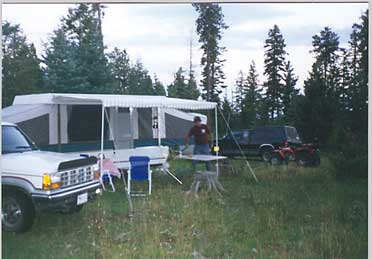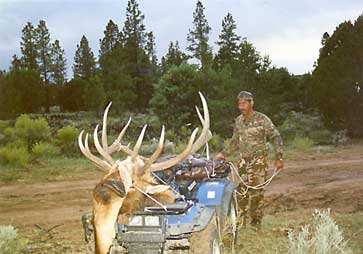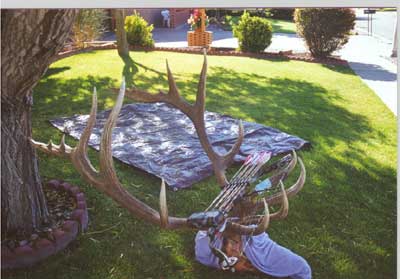My family is new to hunting the southwest, but thanks to the support of local hunters and friends, I have gained confidence in my own hunting abilities. Archery hunting has since become a passion for me and, as my son explores his own hunting abilities, I am sure he will find his own niche in the outdoors. Hunting big game animals like the great Yellowstone elk is an experience in its own right. Coming from Pennsylvania, I had never encountered such large creatures in the wild and I admit that the first time I heard an elk bugle was an awakening experience. To think I would have to take on this massive animal in the wild with only a bow and arrow, and at such close distances, is like jumping from an oncoming freight train at the last possible second. I have spent several years without bagging an animal, but those years I feel were well-spent in learning the animals’ habits, as well as my own abilities. Becoming acclimated to the high elevations 5-10,000 feet above sea level, being prepared to put on several miles a day and overcome the quick changes in weather and making sure you have the necessary equipment to not only prepare and pack out the animal that you harvest, but also being able to find your way back to camp at the end of the day, are all essential to an enjoyable and successful hunt in the southwest. On this particular hunt, we spent several weeks scouting with our sons and spent many hours trying to first locate the animals and then watch their habits. Not being able to hunt the same unit every year, you must spend a lot more time in the woods and must be able to talk with the locals to learn the area you are hunting in. Having a great hunting partner who is familiar with the area aided in getting a close encounter with this monster of the woods. We were, unfortunately, unable to locate any fresh sign during our initial scouting trip and the watering areas were all but non-existent due to a long drought. Several days before the end of the hunt, and after talking to some local ranchers, we were able to locate several sources of springs. The weather too was starting to change in our favor, offering colder temperatures, which would mark the beginning of the rut. My hunting partner called me at home on the last week when he located an area where the elk seemed to particularly like. The area was filled with fresh sign and rubs, and provided a lot of natural cover. He had missed a bull earlier in the day, but felt sure they would return. I quickly packed my camper and headed off to meet him. We spent the evening planning our strategies, and preparing to hunt around a large meadow near a dry streambed. The area seemed to be the natural habitat for what we were looking for. Although elk are very large animals, they are migratory and can move through the woods rather easily and quickly. We had to find their patterns and habits quickly since the hunt was almost at the end. We had found several cows and some large rubs and scrapes at the top of the meadow. That evening we bugled above the meadow and the woods came alive. Several bulls were at the edge of the meadow ripping up the small pine trees. We knew the rut had begun and planned for an early morning assault.
The chase had begun. In ¼-mile increments we had pushed the elk up a deep canyon and onto a large peak. They seemed to slow, maybe knowing that they were now safe from the intruders and began to bugle even louder as though to taunt us. The herd took us on a long and exciting tour of the meadows and canyons as we stalked them for several miles through rough terrain and deep canyons. They carried on like a bunch of school children, each taking turns calling out to us, as if they were daring us. Some with higher pitched squeals, some with deep-long grunts. When we heard this bull, you could tell he was big, and his distinctive deep bugle followed by a raspy grunt set him apart from the rest of the herd. As I gave a cow call from across canyon they would spin into a frenzy.
I could see a break in the canyon, which would allow for a quick last assault. My hunting partner approached from beneath the peak and behind the herd, as I approached above and in front of the bugling bulls. Sneaking through the brush and slipping past a flock of turkeys and a lone mule deer, I was able to make it to the canyon wall undetected. I moved up the steep wall cautiously and managed to slip into the herd. As I stepped onto the plateau, I could hear the herd bull to my right and the rest of the herd coming up quickly from my left with the smaller bulls bugling as they trudged toward me. The dilemma was upon me, should I wait and ambush the oncoming bulls, or pursue the larger bull that now stood 100 yards to my right? I decided not to wait, but to go after the larger herd bull before they caught up to me, and I am glad I did. I could see a huge tine above the pinion tree, which had hidden most of his body, and most of his antlers. I was glad of this since most of the mistakes I have made in the past were to look and eventually shoot at the antlers. With the tree now between us, this allowed me to get even closer as I scurried to keep from getting caught by a lone cow that now was feeding below him. I quickly drew back before I stepped from behind the pinion, as he was quartering away. At that exact moment he turned perfectly broadside to bugle once more, paying attention only to the lone cow. This offered a perfect shoulder shot as I let go of my arrow. I could see the arrow hit his lower front shoulder, but wasn't sure if it had penetrated. I have shot at elk in the past where the arrow simply bounced off the animal without even a scratch.
I marked my shooting lane and went to retrieve my arrow, which I found lying about 10 feet from where I had shot him. I grabbed the arrow and was going back to my quiver to measure the depth of penetration when I saw the bull, down only fifty yards from where I had shot him. I couldn't believe my eyes when I looked at his mass of antlers sticking up from the ground. I still didn't know just how big he was. These were not the bulls that we had tracked to the peak earlier. He was much more massive. As I got closer and began to count the points, I had to sit for a moment to let it all seep in. This massive bull was my first bull elk taken in archery, and what a dandy he was. A once in a lifetime elk by anyone's standards, this typical 9x10 elk, scoring 389 2/8 Gross and 377 6/8 net Pope & Young, gave me the ultimate experience in bow hunting. At last! All the hard work has really paid off.
Thanks to all my friends and hunting partners! Something this big doesn't take himself out of the woods. |
"ULTIMATESPORTSMEN.COM" is a Registered Servicemark.
All Rights Reserved, All content with exception of private works and
corporate trademarked logos are property of Tales of the Ultimate Sportsmen
Back to Stories Index - Your True Tale - Utimate Store - Photos - About Us - Email Us



